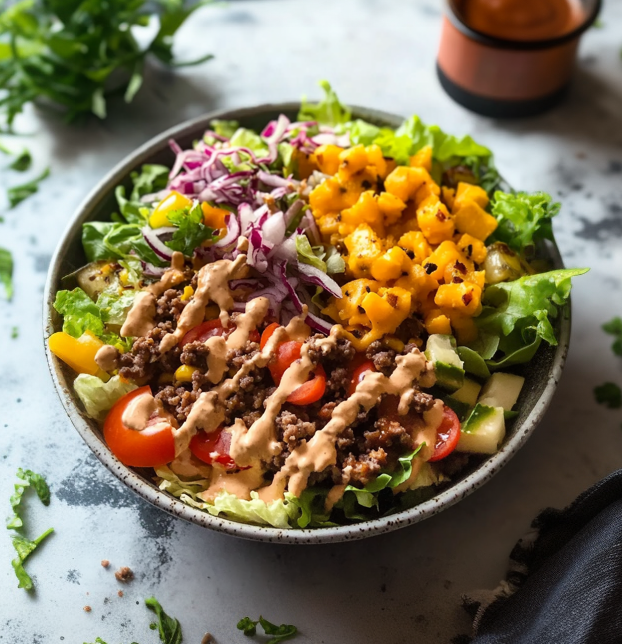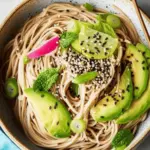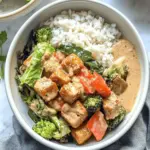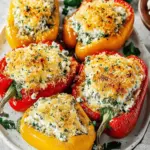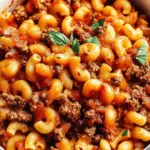The Cheeseburger Bowl offers all the savory flavors of a classic cheeseburger without the bun, making it a low-carb and gluten-free alternative that’s both satisfying and delicious. Packed with lean ground beef, fresh vegetables, and a creamy, tangy burger sauce, this bowl is a versatile meal that can be customized to suit various dietary preferences. Whether you’re looking for a quick weeknight dinner or a hearty lunch, the Cheeseburger Bowl delivers comfort food in a healthier, more accessible form.
Full Recipe:
Ingredients
For the Burger Sauce:
- ¼ cup mayo or Greek yogurt
- ¼ cup ketchup
- 1½ tablespoons Dijon mustard
- 1 teaspoon hot sauce
- 2 tablespoons fresh lemon juice
- ½ tablespoon dill pickle juice
- ¼ teaspoon dried dill
- ¼ teaspoon sweet paprika
- ¼ teaspoon garlic powder
- Salt and pepper to taste
For the Bowl:
- 1 pound lean ground beef (90% lean)
- 1 teaspoon avocado oil
- 1 teaspoon paprika
- ½ teaspoon garlic powder
- ½ teaspoon chili powder
- Salt and ground black pepper to taste
- 8 cups chopped romaine lettuce
- ½ cup diced onion
- 1⅓ cups diced tomatoes
- 4 chopped dill pickles
- ¾ cup shredded cheddar cheese
Directions
- Prepare the Burger Sauce: In a small bowl, whisk together the mayo or Greek yogurt, ketchup, Dijon mustard, hot sauce, lemon juice, dill pickle juice, dried dill, sweet paprika, garlic powder, salt, and pepper. Set aside.
- Cook the Ground Beef: Heat the avocado oil in a pan over medium heat. Add the ground beef, breaking it up with a spatula. Season with paprika, garlic powder, chili powder, salt, and black pepper. Cook until the beef is no longer pink, about 5-7 minutes. Drain any excess grease.
- Assemble the Bowls: Divide the chopped romaine lettuce among four shallow bowls. Top each with an equal portion of the cooked ground beef, diced onion, diced tomatoes, chopped dill pickles, and shredded cheddar cheese.
- Add the Sauce: Drizzle the prepared burger sauce over each assembled bowl. Serve immediately.
Nutrients
Per serving (1 bowl):
- Calories: 390 kcal
- Protein: 30g
- Fat: 24g
- Saturated Fat: 9g
- Trans Fat: 1g
- Polyunsaturated Fat: 3g
- Monounsaturated Fat: 8g
- Cholesterol: 97mg
- Sodium: 1006mg
- Potassium: 882mg
- Carbohydrates: 13g
- Fiber: 4g
- Sugar: 6g
- Vitamin A: 9334 IU
- Vitamin C: 17mg
- Calcium: 248mg
- Iron: 4mg
The Appeal of the Cheeseburger Bowl in Contemporary Dining
One of the main reasons the Cheeseburger Bowl has gained popularity is its adaptability to various nutritional needs without compromising on taste. Traditional cheeseburgers often come with white bread buns, which contribute refined carbs and sometimes unwanted additives. By removing the bun and focusing on fresh, whole ingredients such as crisp romaine lettuce, ripe tomatoes, and diced onions, the dish lowers the carbohydrate content significantly while boosting fiber and vitamins.
This bowl format also aligns well with the trend toward “bowl meals,” which have become a staple for many who want convenient yet wholesome meals. Bowls offer flexibility, ease of preparation, and visually appealing presentations, making them especially attractive for meal prepping, family dinners, and casual dining. The Cheeseburger Bowl, with its layered textures and balanced flavors, fits perfectly into this trend.
Nutrition and Health Benefits
The Cheeseburger Bowl is a nutrient-dense meal that offers a well-rounded profile of macronutrients and micronutrients. The lean ground beef provides a substantial source of high-quality protein, which is essential for muscle repair, immune function, and satiety. The protein content in this dish makes it an excellent choice for those engaged in active lifestyles or anyone looking to maintain balanced nutrition.
Healthy fats play a crucial role in this recipe as well. The use of avocado oil in cooking adds heart-healthy monounsaturated fats, which are known for their benefits in improving cholesterol levels and reducing inflammation. Additionally, the creamy sauce made with mayo or Greek yogurt adds richness while also contributing fats and probiotics if yogurt is chosen. Cheese adds both fat and calcium, supporting bone health.
Vegetables like romaine lettuce, tomatoes, onions, and pickles contribute fiber, vitamins (such as A and C), and antioxidants. Fiber is particularly important for digestive health and can help regulate blood sugar levels. The inclusion of fresh vegetables also balances the richness of the beef and cheese, offering a refreshing crunch and brightness to the bowl.
Customizing the Cheeseburger Bowl for Dietary Preferences
One of the strongest points of the Cheeseburger Bowl is its versatility. While the classic recipe uses ground beef and cheddar cheese, it can be easily customized to accommodate different tastes and dietary restrictions. For example, those following a vegetarian or plant-based diet can substitute ground beef with plant-based protein alternatives such as textured vegetable protein (TVP), crumbled tofu, or seasoned lentils. Vegan cheese and a dairy-free sauce can replace the traditional dairy elements without losing the essence of the dish.
For those aiming to reduce fat intake, leaner cuts of meat such as ground turkey or chicken can be used, or the amount of cheese can be adjusted. The sauce can be made lighter by opting for Greek yogurt instead of mayo, lowering calorie and fat content while still providing creaminess and tang.
The bowl format also allows easy addition or omission of ingredients to tailor sodium levels or allergens, making it suitable for various health conditions like hypertension or lactose intolerance.
The Role of the Special Sauce
A defining characteristic of the Cheeseburger Bowl is the creamy and flavorful burger sauce. This sauce mimics the familiar condiments that are essential to the cheeseburger experience—ketchup, mustard, mayo—but elevates them with the addition of dill pickle juice, lemon juice, and spices like paprika and garlic powder. This combination adds complexity and depth to the sauce, making it more than just a simple dressing.
The sauce ties the ingredients together, providing moisture and a burst of tangy flavor that complements the savory beef and sharp cheddar. It also adds a luxurious texture that contrasts with the crispness of the lettuce and crunch of pickles, enhancing the overall eating experience.
Why the Cheeseburger Bowl is Perfect for Meal Prep and Busy Lifestyles
In today’s fast-paced world, meals that are quick to prepare yet nutritious are highly valued. The Cheeseburger Bowl fits this niche exceptionally well. It can be assembled in under 30 minutes and stored in airtight containers for a couple of days without losing flavor or texture, especially if the sauce is kept separate until serving.
Because of its balanced macronutrient profile, it keeps you full and energized throughout the day, preventing unnecessary snacking. Its portability makes it ideal for packed lunches, office meals, or on-the-go dining. The freshness of the vegetables helps maintain a vibrant and appetizing look even after refrigeration.
Cultural Context and Modern Food Trends
The Cheeseburger Bowl taps into several contemporary food trends that resonate with a wide audience. First, it addresses the growing demand for low-carb, keto-friendly meals that help manage weight and blood sugar. Removing the bun replaces excess carbohydrates with nutrient-rich vegetables, aligning with keto and paleo diets.
Second, the recipe fits well within the “clean eating” movement, emphasizing whole, unprocessed ingredients without artificial additives. Each component of the bowl serves a purpose in flavor and nutrition, demonstrating a thoughtful approach to meal design.
Lastly, the bowl style reflects the current culinary shift towards more visually appealing and Instagram-worthy food presentations. The layers of vibrant greens, red tomatoes, golden cheese, and hearty beef create a colorful and inviting dish that looks as good as it tastes.
Sustainability and Ethical Considerations
Choosing quality ingredients for the Cheeseburger Bowl can also contribute positively to environmental and ethical concerns. Opting for grass-fed, locally sourced beef supports sustainable farming practices and ensures better animal welfare. Incorporating more plant-based components, even occasionally, can reduce the carbon footprint associated with meat production.
Using fresh, seasonal vegetables also aligns with sustainable eating practices. It encourages consumers to connect with their local food systems and reduce reliance on heavily packaged or transported products.
Serving Suggestions and Pairings
While the Cheeseburger Bowl is complete on its own, it can be complemented with various sides and beverages to create a full dining experience. A light, crisp green salad with vinaigrette can enhance freshness. Roasted or steamed vegetables add warmth and additional nutrients.
For beverages, a sparkling water with a slice of lemon or a light beer pairs well, balancing the richness of the dish. For those avoiding alcohol, iced tea or kombucha offers refreshing and digestive-supportive options.
Conclusion
The Cheeseburger Bowl is a brilliant reimagining of a beloved classic, designed for today’s health-conscious and convenience-driven eaters. It successfully captures the nostalgic flavors of a cheeseburger while eliminating excess carbs and incorporating fresh, nutrient-rich vegetables. Its flexibility allows for easy customization across various dietary needs and preferences, making it accessible and appealing to a broad audience.

